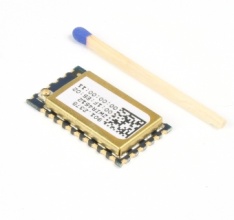Difference between revisions of "ICradio-ZWIR4512-OEM"
| (13 intermediate revisions by 3 users not shown) | |||
| Line 1: | Line 1: | ||
| − | [[file:ZWIR4512.jpg| | + | [[file:ZWIR4512.jpg|x220px|left|thumb|ICradio ZWIR4512 OEM]] |
| − | The ICradio ZWIR4512 OEM module is a [http://en.wikipedia.org/wiki/6LoWPAN | 6loWPAN] radio module. The delivered 6LowPAN radio stack is able to build up a meshing network. Every node | + | The ICradio ZWIR4512 OEM module is a [http://en.wikipedia.org/wiki/6LoWPAN | 6loWPAN] radio module. The delivered 6LowPAN radio stack is able to build up a meshing network. Every node is automatically relaying packets. So the user does not need to care about meshing. Just send packets to the nodes, the network will route the packets to the destination. |
The 6LowPAN Stack is delivered by ZMDi. It is a free for use software library in addition of some C-header files. | The 6LowPAN Stack is delivered by ZMDi. It is a free for use software library in addition of some C-header files. | ||
| − | For an easy startup with the ICradio ZWIR4512 OEM radio modules, In-Circuit deliveres the modules with | + | For an easy startup with the ICradio ZWIR4512 OEM radio modules, In-Circuit deliveres the modules with a small application software. This software connects to the UART and RF interfaces and handles some packets. |
| − | |||
| − | |||
| − | |||
| − | |||
| − | |||
| − | |||
| − | |||
| − | |||
| − | |||
| − | |||
| − | |||
| − | |||
| − | |||
| − | |||
| − | |||
| − | |||
| − | |||
| − | |||
| − | |||
| − | |||
| − | |||
| − | |||
| − | |||
| − | |||
| − | |||
| − | |||
| − | |||
| − | |||
| − | |||
| − | |||
| − | |||
| − | |||
| − | |||
| + | == Downloads == | ||
| + | For further information look at the [[ICradio-ZWIR4512-Documentation]] site or have a look at [[:Category:ICradio ZWIR Modules]]. | ||
| + | To flash a new firmware, you can follow the instructions described at [[Flashing a new ZWIR4512 Firmware]]. | ||
| + | Take a look at our [[:Category:HowTo | HowTo]] Category for some further information. | ||
| − | + | [[Category:ICradio ZWIR Modules]] | |
| − | + | ||
| − | + | ||
| − | + | ||
| − | + | ||
| − | + | ||
| − | + | ||
| − | + | ||
| − | + | ||
| − | + | ||
| − | + | ||
| − | + | ||
| − | [[Category:ICradio Modules]] | + | |
Latest revision as of 17:25, 13 December 2013
The ICradio ZWIR4512 OEM module is a | 6loWPAN radio module. The delivered 6LowPAN radio stack is able to build up a meshing network. Every node is automatically relaying packets. So the user does not need to care about meshing. Just send packets to the nodes, the network will route the packets to the destination. The 6LowPAN Stack is delivered by ZMDi. It is a free for use software library in addition of some C-header files. For an easy startup with the ICradio ZWIR4512 OEM radio modules, In-Circuit deliveres the modules with a small application software. This software connects to the UART and RF interfaces and handles some packets.
[edit] Downloads
For further information look at the ICradio-ZWIR4512-Documentation site or have a look at Category:ICradio ZWIR Modules.
To flash a new firmware, you can follow the instructions described at Flashing a new ZWIR4512 Firmware. Take a look at our HowTo Category for some further information.
